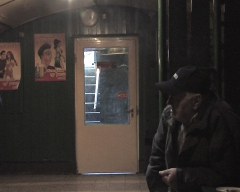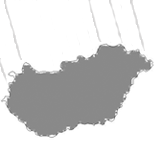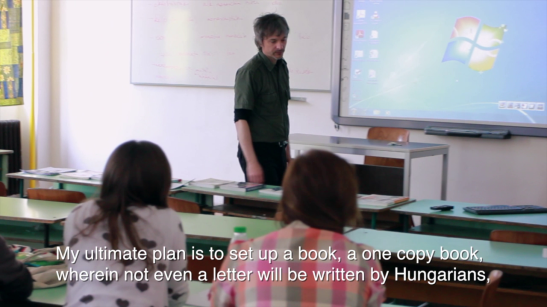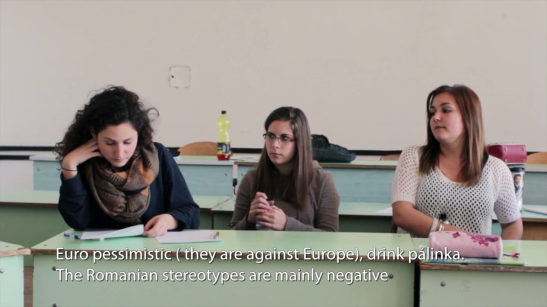Context & Identity in Contemporary Hungarian Art
Reimagining the near past and constructing local identities. A Fulbright project by Linnea West (2012-13)
Meeting with Zsolt Keserue
I met with Zsolt Keserue over an outdoor coffee (finally enjoying the warm Spring weather) here in Budapest. Keserue is a documentary filmmaker and fine artist. I was particularly interested in discussing his most recent project, still ongoing, called National Textbook. National Textbook (begun in 2009) is a montage publication which gathers data about Hungary, its formation and history, from textbooks used in the public education systems of other countries. As Keserue describes the project on his website:
“The surprising and contradictory stories – all reviewed and certified by each country’s national textbook committee – put next to one another in one publication inspire reflection upon historical memory and stereotypes, revealing the relativity of what is regarded as objective.”
Ultimately the final product will be a collage artist’s book. It is ongoing because of the long process of getting textbooks from across the world and finding translators who can put descriptions into Hungarian.
Naturally, given their common history and shifting borders, the surrounding countries sometimes offer the most interesting comparisons. For example, the Turkish textbook describes positively the great Ottoman period when they controlled part of what is today Hungarian and brought civilized culture; this period of conquest is represented as a low point by Hungarian textbooks. Keserue thinks of this project as serving a particular need in Hungarian society, so all the information is in Hungarian and he does not feel the need to display the differing accounts next to Hungarian textbooks, because he assumes his audience will be familiar.
Last year through tranzit.hu’s Artists at Schools program, Keserue launched a second part of the project in a local high school. He worked with the students in a history class to both deconstruct some of the foreign texts he had received and, as a new part of the project, the students asked foreign friends and acquaintances what they thought about Hungary. They collected and pooled together the stereotypes as a complimentary part of the project, which they displayed across from Keserue’s textbook display during a 4-day workshop/seminar/gallery show. This was instructive for the students, underscoring the artist’s original intention of presenting the many biased forms history can take, so that they can consider how history is told, taught, and institutionalized as well as consider their own history from a different perspective. Although motivated by the current political situation, Keserue never inserts his own viewpoint into the project. The functioning of the different texts merely calls attention to the structures that institutionalize our knowledge of the world, asking that the biases behind history be considered.
Perhaps similarly, in his 2008 documentary film Blast Furnace, he tells the story of cultural life in Dunaújváros, a city founded in the 1950s to be the model of a modern, Socialist industrial city. He interviews people who were active in the culture scene from its initial founding, and pieces together their different stories with archival photos and film including present-day footage. With a focus on interviews, the approach to history is a lived, personal one that includes the biased accounts of many players of different generations. This approach is also found in the 2008 film Who was King Matthias?
 Superficially a simple historical question, through the interviews with male bar patrons, the answers reveal a pub society of heavy drinkers where talk is used to enhance social position. Matthias Corvinus was king of Hungary in the second half of the 15th century, popularly remembered as Matthias ‘the just.’ But in the pub this legend becomes a barely remembered figure useful for arguments and the vague legend is interpreted idiosyncratically according to their own values. If National Textbook opens up the institutionalization of historical memory, then Who was King Matthias? opens up the personal and everyday manner in which collective historical memory functions. In neither does Keserue suggest a conception of history as a stable or fixed entity; rather, one sees on the greater societal or smaller individual scale how versions of history compete for our attention in open-ended systems subject to change and interpretation.
Superficially a simple historical question, through the interviews with male bar patrons, the answers reveal a pub society of heavy drinkers where talk is used to enhance social position. Matthias Corvinus was king of Hungary in the second half of the 15th century, popularly remembered as Matthias ‘the just.’ But in the pub this legend becomes a barely remembered figure useful for arguments and the vague legend is interpreted idiosyncratically according to their own values. If National Textbook opens up the institutionalization of historical memory, then Who was King Matthias? opens up the personal and everyday manner in which collective historical memory functions. In neither does Keserue suggest a conception of history as a stable or fixed entity; rather, one sees on the greater societal or smaller individual scale how versions of history compete for our attention in open-ended systems subject to change and interpretation.





